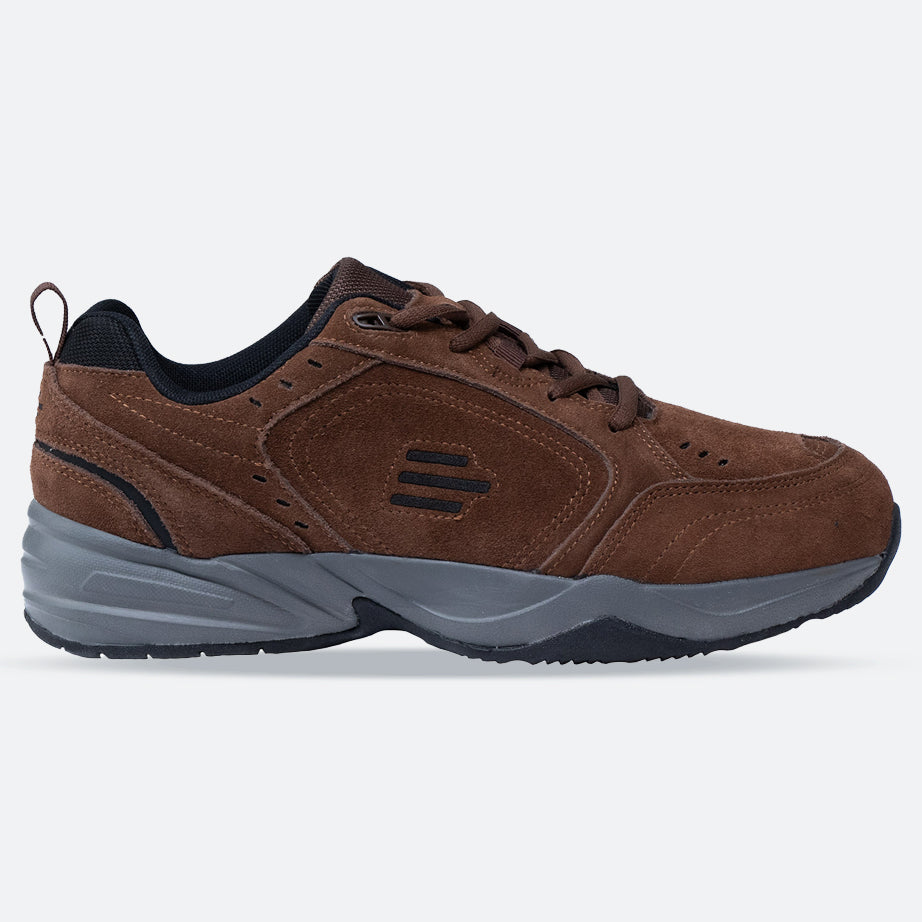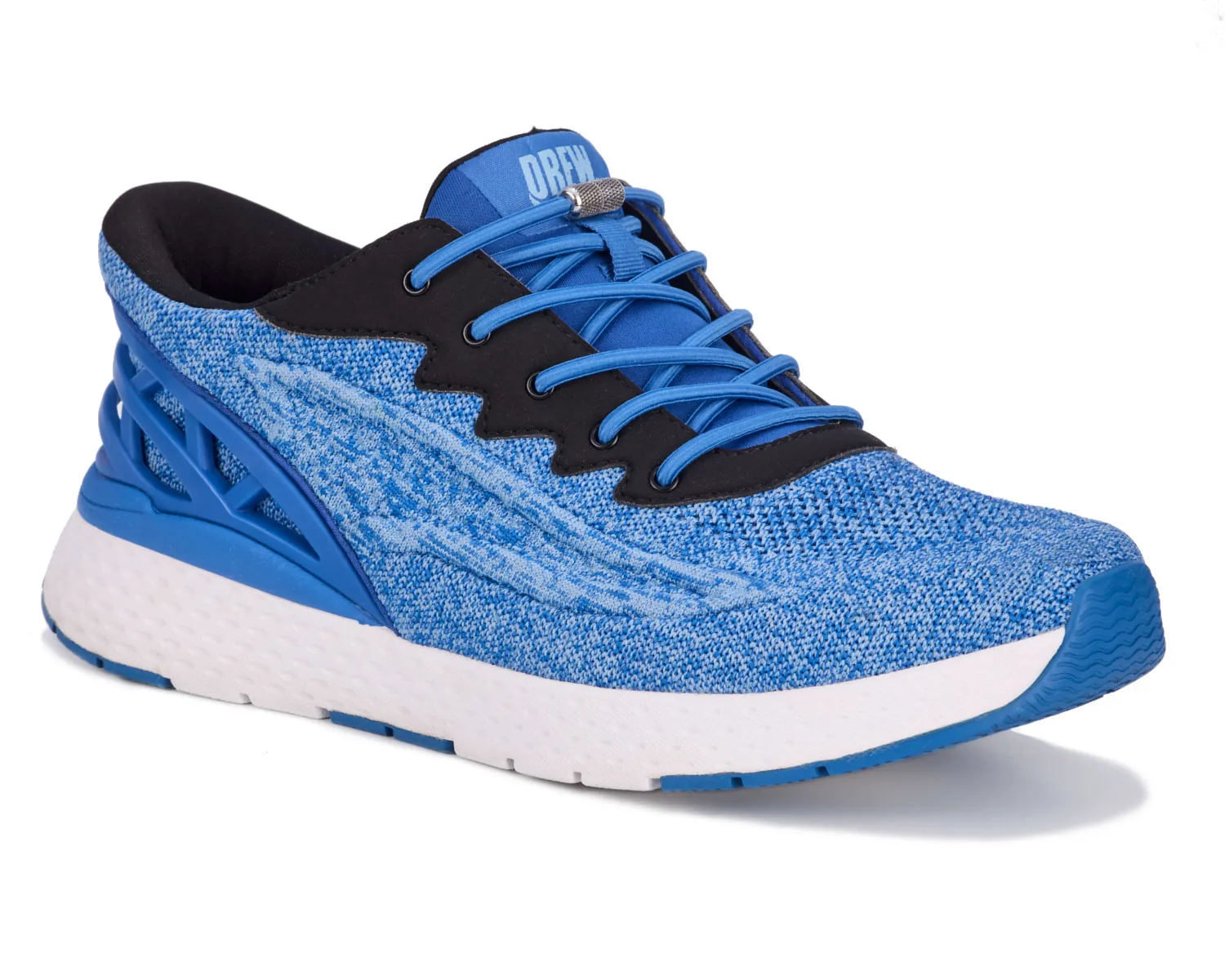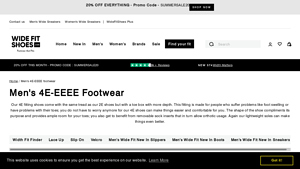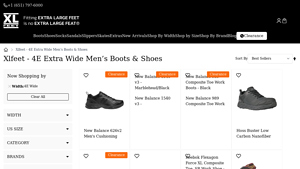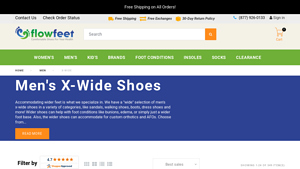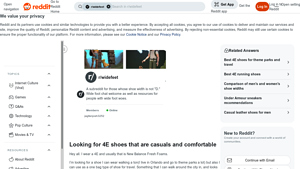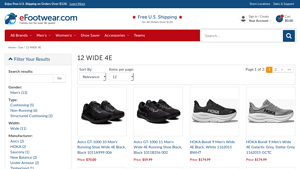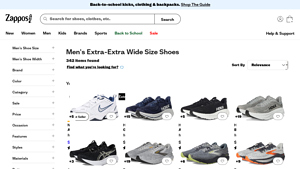4E Wide Shoes Guide: Type,Cost,Material…
Introduction: Navigating the Global Market for 4e wide shoes
Sourcing 4E wide shoes for diverse markets can be a significant challenge for B2B buyers, particularly when accommodating the varying needs of customers with wider feet. These specialized footwear options not only provide comfort but also address health concerns related to foot swelling and conditions like diabetes. In this comprehensive guide, we will explore the intricacies of the global 4E wide shoes market, detailing the different types of shoes available, their specific applications, and essential insights for vetting suppliers.
International buyers from regions such as Africa, South America, the Middle East, and Europe—including key markets like Nigeria and Germany—will find actionable strategies to make informed purchasing decisions. This guide will cover pricing structures, quality benchmarks, and the latest trends in 4E wide footwear, ensuring that businesses can effectively meet the demands of their customers.
By equipping B2B buyers with the right knowledge and resources, this guide aims to streamline the sourcing process, enhance customer satisfaction, and ultimately drive sales in an increasingly competitive marketplace. Understanding the nuances of 4E wide shoes is not just about comfort; it’s about providing solutions that can transform the footwear experience for a significant segment of the population.
Understanding 4e wide shoes Types and Variations
| Type Name | Key Distinguishing Features | Primary B2B Applications | Brief Pros & Cons for Buyers |
|---|---|---|---|
| Athletic Sneakers | Lightweight, breathable materials, removable insoles, extra depth | Sports retailers, health and wellness shops | Pros: Comfort, versatility; Cons: Limited formal use. |
| Safety Boots | Reinforced toe caps, slip-resistant soles, waterproof options | Construction, manufacturing, outdoor retail | Pros: Durability, safety compliance; Cons: Heavier weight. |
| Casual Slip-Ons | Easy wear, flexible design, often made from soft materials | Retail clothing stores, casual footwear shops | Pros: Convenience, style; Cons: Less arch support. |
| Hiking Boots | Rugged construction, enhanced ankle support, traction-focused soles | Outdoor gear retailers, travel and adventure shops | Pros: Stability, weather resistance; Cons: Bulkiness. |
| Dress Shoes | Elegant designs, premium materials, orthotic-friendly features | Corporate apparel suppliers, formal wear outlets | Pros: Professional appearance, comfort; Cons: Limited styles available. |
What Are the Characteristics of 4E Athletic Sneakers?
4E athletic sneakers are designed for those requiring extra room without sacrificing performance. They feature lightweight and breathable materials, often incorporating removable insoles to accommodate custom orthotics. These shoes are ideal for health and wellness businesses that focus on active lifestyles, providing comfort and flexibility for sports and casual wear. When purchasing, buyers should consider the shoe’s intended use, as these sneakers may not be suitable for formal settings.
How Do 4E Safety Boots Stand Out in the Market?
Safety boots in the 4E width category are characterized by their reinforced toe caps and slip-resistant soles, essential for protecting workers in hazardous environments. They often come with waterproof options, enhancing their suitability for outdoor work. Businesses in construction and manufacturing sectors should prioritize these boots for their durability and compliance with safety regulations. Buyers must evaluate the weight and comfort level, as some models can be bulkier than standard footwear.
What Makes Casual Slip-Ons Popular Among B2B Buyers?
Casual slip-ons offer a convenient footwear option with a flexible design that caters to various foot shapes. They are often crafted from soft materials, making them comfortable for everyday wear. Retailers focusing on casual footwear can benefit from stocking these models, as they appeal to customers looking for ease of use. However, buyers should be aware that while they provide convenience, they may lack the arch support required for prolonged wear.
Why Are 4E Hiking Boots Essential for Outdoor Retailers?
Hiking boots designed in the 4E width provide rugged construction and enhanced ankle support, crucial for stability on uneven terrain. Their traction-focused soles ensure safety during outdoor activities, making them a staple for outdoor gear retailers. When considering these products, businesses should highlight their weather resistance and durability, although potential drawbacks include their bulkiness, which may deter some customers.
How Do 4E Dress Shoes Cater to Professional Needs?
4E dress shoes combine elegance with functionality, featuring premium materials and orthotic-friendly designs. They are suitable for corporate environments, making them a valuable addition for suppliers of formal wear. Buyers should assess the variety of styles available, as options may be limited compared to traditional widths. The key advantage is their ability to offer comfort without compromising on a professional appearance, a critical factor for many businesses.
Key Industrial Applications of 4e wide shoes
| Industry/Sector | Specific Application of 4E Wide Shoes | Value/Benefit for the Business | Key Sourcing Considerations for this Application |
|---|---|---|---|
| Healthcare | Comfortable footwear for healthcare professionals | Reduces foot fatigue, enhancing productivity and care | Look for slip-resistant and easy-to-clean materials; consider local regulations regarding healthcare footwear. |
| Construction | Safety boots for workers with wider feet | Improved safety and comfort leads to higher productivity | Ensure compliance with safety standards; consider waterproof and slip-resistant features. |
| Retail | Employee footwear for staff with foot conditions | Enhanced employee satisfaction and reduced turnover | Choose durable materials; assess styles that align with brand image. |
| Hospitality | Shoes for service staff in restaurants and hotels | Increases staff comfort, leading to better customer service | Focus on stylish yet functional designs; prioritize easy maintenance and comfort. |
| Sports and Recreation | Athletic shoes for wider-footed athletes | Improved performance and reduced injury risk | Source from reputable brands; ensure a variety of styles for different activities. |
How Are 4E Wide Shoes Beneficial in the Healthcare Sector?
In the healthcare sector, professionals often spend long hours on their feet, making comfort paramount. 4E wide shoes provide ample space for foot swelling and conditions like bunions or diabetes, significantly reducing fatigue. By sourcing slip-resistant and easy-to-clean footwear, healthcare facilities can enhance staff productivity and patient care quality. International buyers should consider local regulations regarding healthcare footwear to ensure compliance.
Why Are 4E Wide Shoes Essential in Construction?
Construction workers frequently face tough environments, necessitating sturdy footwear. 4E wide safety boots cater to those with wider feet, enhancing comfort and reducing fatigue during long shifts. These shoes also often include features like waterproofing and slip resistance, essential for safety on job sites. When sourcing, businesses should ensure that the footwear meets local safety standards to protect their workforce effectively.
What Role Do 4E Wide Shoes Play in the Retail Industry?
In retail, employees are on their feet for extended periods, requiring comfortable footwear to maintain high levels of service. 4E wide shoes help staff with foot conditions work without discomfort, leading to higher job satisfaction and reduced turnover rates. Retailers should focus on durable materials and styles that align with their brand image while also providing comfort. Sourcing from reliable manufacturers can ensure consistent quality.
How Do 4E Wide Shoes Enhance Hospitality Services?
The hospitality industry demands that service staff remain on their feet for long hours, necessitating comfortable and stylish footwear. 4E wide shoes provide the necessary support while allowing for a professional appearance. By investing in high-quality footwear, hotels and restaurants can enhance staff comfort, which directly translates to improved customer service. Buyers should prioritize easy maintenance and comfort features when sourcing these shoes.
What Are the Advantages of 4E Wide Shoes in Sports and Recreation?
Athletes with wider feet often struggle to find suitable footwear that provides both comfort and performance. 4E wide athletic shoes cater to this demographic, reducing the risk of injuries and enhancing overall performance. When sourcing, it’s crucial to choose reputable brands that offer a range of styles for various sports activities. Ensuring proper fit and comfort can significantly impact an athlete’s performance and enjoyment.
3 Common User Pain Points for ‘4e wide shoes’ & Their Solutions
Scenario 1: Sizing Confusion Leading to Returns
The Problem: One of the most significant challenges for B2B buyers of 4E wide shoes is the confusion surrounding sizing. With varying standards across brands and regions, many buyers find themselves receiving shoes that do not fit their specifications. This sizing inconsistency can lead to high return rates, resulting in additional costs and logistical headaches. For retailers in regions like Africa or South America, where accessibility to exchange options can be limited, this issue compounds, leading to customer dissatisfaction.
The Solution: To mitigate sizing confusion, B2B buyers should invest in a comprehensive sizing guide that includes specific measurements for each brand they intend to stock. It’s advisable to conduct a thorough assessment of the fit across different brands, documenting the nuances in sizing. Incorporating a “fit finder” tool on the retail website can help customers identify their correct size based on their measurements. Additionally, offering a limited-time exchange program can encourage customers to try the shoes risk-free, thereby reducing return rates and increasing customer loyalty.
Scenario 2: Limited Stock Availability of Popular Styles
The Problem: B2B buyers often face the issue of limited stock availability for specific styles of 4E wide shoes. This is particularly frustrating when trying to meet customer demand for popular brands or styles that cater to individuals with wider feet. Retailers may miss sales opportunities due to stockouts, impacting overall revenue and customer satisfaction.
The Solution: To tackle stock availability issues, B2B buyers should establish strong relationships with manufacturers and distributors to gain insights into upcoming trends and stock levels. Implementing a demand forecasting system can help predict which styles are likely to be popular, enabling proactive ordering. Additionally, diversifying suppliers can ensure that there are alternative options available when certain styles are out of stock. Buyers should also consider pre-order options for customers, allowing them to secure popular items before they are released, which can drive sales and enhance customer engagement.
Scenario 3: Navigating Quality Concerns with Bulk Orders
The Problem: Quality assurance is a critical concern for B2B buyers, especially when placing bulk orders for 4E wide shoes. There is often fear that the shoes may not meet quality standards, leading to complaints and potential damage to the retailer’s reputation. This issue can be exacerbated in international trade, where buyers may have limited opportunities to inspect products before they arrive.
The Solution: To ensure quality when purchasing 4E wide shoes in bulk, buyers should conduct thorough due diligence on suppliers. Requesting samples before placing large orders allows for a firsthand assessment of the product’s quality. Establishing quality control agreements with suppliers can also be beneficial, detailing the specific standards that must be met. Additionally, buyers should explore options for third-party inspections prior to shipment, ensuring that products conform to agreed-upon specifications. By implementing these practices, B2B buyers can significantly reduce the risk of receiving subpar products and build trust with their customer base.
Strategic Material Selection Guide for 4e wide shoes
What Are the Key Materials Used in 4E Wide Shoes?
When selecting materials for 4E wide shoes, it is essential to consider their properties, advantages, and limitations, especially for international B2B buyers. The following analysis covers four common materials used in the manufacture of these shoes, focusing on their performance characteristics and suitability for various applications.
How Does Leather Perform as a Material for 4E Wide Shoes?
Leather is a traditional choice for footwear due to its durability and natural breathability. It typically offers a temperature rating that can withstand moderate heat without degrading, making it suitable for various climates. Leather’s natural resistance to wear and tear enhances the longevity of shoes, and it molds to the foot over time, providing a custom fit.
Pros: Leather is highly durable, offers excellent comfort, and provides a classic aesthetic appeal. It can also be treated for water resistance, making it suitable for outdoor applications.
Cons: The primary drawbacks include higher costs and the complexity of manufacturing, as leather requires specific tanning processes. Additionally, it may not perform well in extreme wet conditions unless treated.
Impact on Application: Leather is compatible with various orthotic inserts, enhancing comfort for users with foot conditions. However, international buyers should ensure compliance with environmental regulations regarding leather sourcing.
What Role Does Synthetic Mesh Play in 4E Wide Shoe Design?
Synthetic mesh materials are increasingly popular in athletic and casual footwear due to their lightweight nature and breathability. These materials often have a good temperature rating, allowing for effective moisture management during physical activities.
Pros: Synthetic mesh is typically more affordable than leather, lightweight, and offers excellent ventilation. It is also easier to clean and maintain.
Cons: While durable, synthetic mesh may not provide the same level of support or longevity as leather. It can also be less aesthetically pleasing for formal applications.
Impact on Application: Synthetic mesh is ideal for athletic and casual 4E wide shoes, especially in warmer climates. Buyers from regions with high humidity should consider moisture-wicking properties for comfort.
How Do Rubber Soles Enhance the Performance of 4E Wide Shoes?
Rubber is a common choice for shoe soles due to its excellent grip and shock absorption properties. It withstands various environmental conditions, making it suitable for outdoor and athletic applications.
Pros: Rubber soles provide superior traction and durability, enhancing safety and comfort. They are also resistant to abrasion and can handle a range of temperatures.
Cons: The main limitation is that rubber soles can add weight to the shoes, which may be a concern for athletic performance. Additionally, high-quality rubber can be more expensive.
Impact on Application: Rubber soles are essential for safety footwear, particularly in industrial settings. Buyers should ensure that the rubber meets international standards for slip resistance and durability.
What Benefits Does EVA Foam Offer for 4E Wide Shoes?
EVA (Ethylene Vinyl Acetate) foam is commonly used for cushioning and insoles in footwear. It is known for its lightweight properties and excellent shock absorption capabilities.
Pros: EVA foam is cost-effective, lightweight, and provides good comfort and cushioning. It is also resistant to UV radiation, making it suitable for outdoor use.
Cons: While EVA foam offers comfort, it may not provide the same level of durability as rubber or leather. Over time, it can compress and lose its supportive properties.
Impact on Application: EVA foam is ideal for casual and athletic footwear, particularly for consumers seeking comfort. International buyers should consider the foam’s compliance with health and safety standards.
Summary Table of Material Selection for 4E Wide Shoes
| Material | Typical Use Case for 4E Wide Shoes | Key Advantage | Key Disadvantage/Limitation | Relative Cost (Low/Med/High) |
|---|---|---|---|---|
| Leather | Dress shoes, formal wear | Durable, molds to foot | Higher cost, complex manufacturing | High |
| Synthetic Mesh | Athletic shoes, casual wear | Lightweight, breathable | Less durable, less formal appeal | Medium |
| Rubber | Safety shoes, outdoor footwear | Superior traction, durable | Adds weight, can be expensive | Medium to High |
| EVA Foam | Casual shoes, insoles | Lightweight, good cushioning | Can compress over time | Low |
This guide provides valuable insights into material selection for 4E wide shoes, helping international B2B buyers make informed decisions based on performance, cost, and compliance considerations.
In-depth Look: Manufacturing Processes and Quality Assurance for 4e wide shoes
What Are the Key Stages in the Manufacturing Process of 4E Wide Shoes?
The manufacturing of 4E wide shoes involves several critical stages that ensure comfort, durability, and fit, essential for customers with wider foot profiles. The main stages include material preparation, forming, assembly, and finishing.
Material Preparation
The journey of a 4E wide shoe begins with the careful selection and preparation of materials. Manufacturers often use high-quality leather, synthetic fabrics, and breathable mesh to create a flexible and durable shoe. The material is cut into specific shapes that accommodate the wider toe box and deeper heel cup characteristic of 4E shoes. This stage may also involve the treatment of materials for water resistance or breathability, depending on the shoe’s intended use.
Forming
In the forming stage, the cut materials are molded into the desired shapes. Advanced techniques such as heat molding or injection molding are often employed to ensure that the shoes conform to the unique contours of wider feet. This process is crucial for providing the necessary support and comfort. Additionally, manufacturers may use ergonomic designs to enhance the natural movement of the foot, which is particularly important for individuals with foot issues.
Assembly
The assembly stage involves stitching together the upper and lower parts of the shoe. This is where the craftsmanship becomes evident; skilled workers or automated machines ensure that all components are securely attached. Quality control measures at this stage are vital, as they help to ensure that the shoe maintains its structural integrity. Components such as removable sock liners, which allow for orthotic inserts, are added to enhance comfort and customization.
Finishing
Finally, the finishing stage includes quality checks, polishing, and the addition of any necessary branding. This stage not only focuses on aesthetics but also on the functional performance of the shoe. Final inspections are conducted to ensure that each pair meets the required standards for durability and comfort.
How Is Quality Assurance Implemented in 4E Wide Shoe Manufacturing?
Quality assurance (QA) is a fundamental aspect of the manufacturing process for 4E wide shoes. Adhering to international standards, such as ISO 9001, ensures that manufacturers consistently produce high-quality products. Additionally, specific industry certifications like CE mark (Conformité Européenne) may apply, particularly for footwear sold in the European market.
Key Quality Control Checkpoints
To maintain high standards, manufacturers implement several quality control checkpoints throughout the production process:
-
Incoming Quality Control (IQC): This stage involves inspecting raw materials upon arrival to ensure they meet predefined specifications. Any substandard materials are rejected to prevent defects in the final product.
-
In-Process Quality Control (IPQC): During the manufacturing stages, periodic checks are performed to monitor the production process. This includes verifying the accuracy of material cuts, the integrity of stitching, and the overall assembly quality.
-
Final Quality Control (FQC): Before the shoes are packaged and shipped, a final inspection is conducted. This includes checking for defects, ensuring proper sizing, and validating the overall performance of the shoes.
What Testing Methods Are Commonly Used for 4E Wide Shoes?
Common testing methods include:
-
Dimensional Checks: Verifying that the shoes adhere to the specified dimensions for width and length, ensuring they meet the 4E criteria.
-
Comfort and Fit Testing: Conducting wear tests with individuals who have wider feet to gather feedback on comfort, support, and fit.
-
Durability Testing: Subjecting the shoes to stress tests to evaluate their performance under different conditions, such as flexibility, resistance to wear, and water resistance.
How Can B2B Buyers Verify Supplier Quality Control?
For B2B buyers, particularly those from diverse markets like Africa, South America, the Middle East, and Europe, ensuring supplier quality control is crucial. Here are several actionable strategies:
-
Supplier Audits: Conducting regular audits of suppliers can provide insight into their manufacturing processes and quality control systems. This helps to assess compliance with international standards and best practices.
-
Reviewing Quality Reports: Suppliers should provide detailed quality reports that outline their QA processes, results from quality checks, and any certifications obtained. Reviewing these documents can help buyers make informed decisions.
-
Third-Party Inspections: Engaging third-party inspection services can add an extra layer of assurance. These organizations can conduct independent assessments of the supplier’s manufacturing processes and product quality.
-
Certifications Verification: Buyers should verify that suppliers hold relevant certifications such as ISO 9001, CE, or any local certifications specific to their region. This adds credibility to the supplier’s claims regarding quality assurance.
What Are the Quality Control Nuances for International B2B Buyers?
International B2B buyers must navigate specific quality control nuances when sourcing 4E wide shoes. Different regions may have varying standards and expectations. For example, European markets may place a higher emphasis on CE certification, while buyers in Africa might prioritize affordability without compromising on quality.
Understanding local consumer preferences, regulatory requirements, and cultural considerations can also influence quality expectations. It’s crucial for buyers to establish clear communication channels with suppliers and possibly collaborate on developing quality benchmarks that align with their market needs.
In conclusion, the manufacturing processes and quality assurance measures for 4E wide shoes are designed to ensure that products meet the diverse needs of consumers with wider feet. By understanding these processes, B2B buyers can make informed decisions and select reliable suppliers that prioritize quality and customer satisfaction.
Practical Sourcing Guide: A Step-by-Step Checklist for ‘4e wide shoes’
Introduction
This guide is designed to assist B2B buyers in effectively sourcing 4E wide shoes, which are crucial for consumers with wider feet requiring specialized footwear. By following this step-by-step checklist, you will ensure that your procurement process is thorough, efficient, and tailored to the needs of your market.
Step 1: Identify Market Demand
Understanding the specific needs of your target market is essential. Conduct market research to determine the demographics of customers who require 4E wide shoes, such as individuals with foot conditions or those simply needing extra width. This knowledge will help you choose the right styles and quantities that align with consumer demand.
Step 2: Define Your Technical Specifications
Establish clear technical specifications for the shoes you intend to source. Consider factors such as material (e.g., leather, mesh), sole type (lightweight or slip-resistant), and design (laced, slip-on, or Velcro). Defining these specifications ensures that you meet both comfort and functionality requirements, which are critical for end-users.
Step 3: Evaluate Potential Suppliers
Before making a commitment, thoroughly vet potential suppliers. Request company profiles, product catalogs, and references from other buyers in similar markets. Look for suppliers with experience in producing 4E wide shoes, as their expertise can significantly impact product quality and reliability.
- Consider supplier certifications such as ISO or relevant industry standards to ensure compliance with safety and quality benchmarks.
- Inquire about their ability to meet your volume needs and lead times, as this will affect your inventory management.
Step 4: Assess Product Quality
Quality assurance is paramount when sourcing footwear. Request samples of 4E wide shoes to evaluate their construction, materials, and overall comfort. Pay attention to features such as:
- Removable sock inserts that allow for orthotic use, enhancing comfort for users with specific foot needs.
- Toe box depth and width to ensure adequate space for the toes, which is vital for user satisfaction.
Step 5: Negotiate Pricing and Terms
Once you have identified suitable suppliers and assessed their product quality, it’s time to negotiate pricing and terms. Discuss bulk order discounts, payment terms, and shipping costs to secure the best deal. Ensure that you factor in:
- Total landed cost, which includes shipping, tariffs, and any additional fees.
- Return policies and warranty options to protect your investment in case the products do not meet your expectations.
Step 6: Implement a Trial Order
Before placing a large order, consider initiating a trial order. This smaller batch will allow you to evaluate the supplier’s reliability and the product’s performance in real market conditions. Collect feedback from your customers to assess satisfaction and make any necessary adjustments before scaling up your order.
Step 7: Establish Long-Term Relationships
Building a strong relationship with your supplier can yield long-term benefits. Maintain open lines of communication to discuss product improvements, upcoming trends, and potential collaborations. A reliable partnership can enhance your supply chain efficiency and provide a competitive edge in the market.
By adhering to this checklist, B2B buyers can streamline the sourcing process for 4E wide shoes, ensuring they meet the needs of their customers while maintaining high standards of quality and service.
Comprehensive Cost and Pricing Analysis for 4e wide shoes Sourcing
What Are the Key Cost Components in Sourcing 4E Wide Shoes?
When analyzing the cost structure of 4E wide shoes, several critical components come into play. Firstly, materials are a significant factor, comprising the cost of fabrics, rubber soles, and any specialized components such as orthotic inserts. High-quality materials can drive up the price but are essential for ensuring durability and comfort, especially for shoes designed for specific foot conditions.
Labor costs are another crucial component. The complexity of manufacturing 4E shoes, which often require specialized techniques for width and depth, can increase labor expenses. This is particularly relevant in regions where skilled labor is in demand or where labor laws impose additional costs.
Manufacturing overhead includes expenses related to utilities, rent, and equipment maintenance, all of which can vary by region. Additionally, tooling costs are significant for custom molds or dies, particularly if the shoes are tailored to unique specifications. Companies should also account for quality control (QC) measures, which ensure that products meet safety and comfort standards, as defects can lead to costly returns.
Finally, logistics must be factored in, encompassing shipping, handling, and warehousing. These costs can fluctuate based on the destination, especially for international shipments.
How Do Price Influencers Affect the Sourcing of 4E Wide Shoes?
Several factors influence the pricing of 4E wide shoes, with volume and minimum order quantities (MOQ) being paramount. Suppliers often offer better pricing per unit when larger quantities are ordered, making it beneficial for buyers to consolidate their purchases.
Specifications and customization also play a role in pricing. Custom designs or additional features such as waterproofing can increase costs. Therefore, buyers should balance their requirements with budget constraints.
Material quality directly impacts price; premium materials lead to higher costs but may offer better performance and longevity. Certifications such as ISO standards or eco-friendly labels can also influence pricing, with compliant products often commanding a premium.
Supplier factors, including reputation and reliability, can affect pricing. Established suppliers may charge more for their products due to proven quality and service levels. Lastly, the choice of Incoterms can significantly affect overall costs, as they determine who bears the risk and costs associated with shipping and delivery.
What Are the Best Buyer Tips for Negotiating 4E Wide Shoe Prices?
International B2B buyers, particularly from regions such as Africa, South America, the Middle East, and Europe, can optimize their sourcing strategies through effective negotiation and understanding of costs. Negotiation is essential; buyers should aim to establish long-term relationships with suppliers, which can lead to more favorable pricing and terms.
Consider the Total Cost of Ownership (TCO) rather than just the upfront costs. This includes evaluating the durability and performance of the shoes, which can reduce long-term expenses related to replacements or customer dissatisfaction.
Buyers should also be aware of pricing nuances specific to their regions. For instance, import tariffs, taxes, and local regulations can significantly impact the final price. Understanding these factors can lead to more informed decisions and better negotiations.
Lastly, maintaining flexibility in specifications can lead to cost savings. If certain features can be modified or eliminated without compromising quality, it may allow buyers to access more competitive pricing.
Conclusion
In summary, sourcing 4E wide shoes involves a detailed understanding of cost components, price influencers, and effective negotiation strategies. By focusing on these aspects, international buyers can ensure they make informed purchasing decisions that align with their budgetary constraints and quality requirements. Always remember that prices are indicative and can vary based on market conditions and supplier negotiations.
Alternatives Analysis: Comparing 4e wide shoes With Other Solutions
Introduction to Alternatives for 4E Wide Shoes
When catering to customers with specific foot needs, particularly those requiring extra width, understanding the alternatives to 4E wide shoes is essential. While 4E wide shoes provide a comfortable solution for individuals with wider feet, there are other options available that can also address similar challenges. This analysis will compare 4E wide shoes with two viable alternatives: custom orthotics and specialized footwear brands that focus on wider fittings, such as EEEE wide shoes.
Comparison Table
| Comparison Aspect | 4E Wide Shoes | Custom Orthotics | EEEE Wide Shoes |
|---|---|---|---|
| Performance | Excellent comfort and support for wider feet | Tailored support, depending on foot condition | Similar comfort level to 4E shoes, but with greater width options |
| Cost | Moderate (typically $100-$250) | High (can range from $200-$600) | Similar to 4E shoes ($100-$300) |
| Ease of Implementation | Readily available in stores | Requires assessment and fitting | Readily available, but limited styles |
| Maintenance | Low (occasional cleaning) | Moderate (may need replacement) | Low (similar to 4E shoes) |
| Best Use Case | General use for those needing wider fit | Specific foot issues (e.g., plantar fasciitis) | For individuals needing even wider options than 4E |
Detailed Breakdown of Alternatives
Custom Orthotics
Custom orthotics are specially designed insoles created to address specific foot problems. They can provide tailored support, alleviating pain and discomfort for individuals with various foot conditions. The main advantage of custom orthotics is their personalized nature; they adapt to an individual’s unique foot shape and issues. However, they can be quite expensive and often require a fitting appointment with a specialist. For B2B buyers, investing in custom orthotics can be worthwhile for clients with specific medical conditions, but it may not be practical for general use.
EEEE Wide Shoes
EEEE wide shoes offer an alternative for individuals who require even more space than provided by 4E shoes. These shoes are designed to accommodate extremely wide feet, providing ample room in the toe box and overall fit. While they can be beneficial for those needing more width, their availability may be limited compared to 4E options, and they may not provide the same level of variety in styles. EEEE shoes can be a suitable solution for those who have outgrown the 4E size but come with potential drawbacks in terms of style and accessibility.
Conclusion: How to Choose the Right Footwear Solution
When selecting the right solution for wider footwear needs, B2B buyers should consider the specific requirements of their customer base. If comfort and availability are the primary concerns, 4E wide shoes are an excellent choice due to their moderate cost and variety. For clients with specific foot issues, custom orthotics may provide the necessary support, albeit at a higher price and with a more complex acquisition process. Alternatively, EEEE wide shoes can serve those requiring even more space but may lack in variety. Ultimately, the decision should align with the specific needs of the target market, ensuring that comfort, cost, and availability are balanced effectively.
Essential Technical Properties and Trade Terminology for 4e wide shoes
What Are the Essential Technical Properties of 4E Wide Shoes?
When considering 4E wide shoes for your business, understanding their technical properties is crucial for ensuring comfort, quality, and customer satisfaction. Here are several key specifications that define these shoes:
-
Width and Depth Specifications
– Definition: The “4E” designation indicates a width that is approximately 1.5 times wider than standard shoes. Additionally, the toe box is designed with increased depth to accommodate foot swelling and provide comfort.
– B2B Importance: Offering 4E width shoes can cater to a significant market segment, particularly in regions where foot health is a priority. This specification is essential for retailers aiming to meet the needs of consumers with wider feet or specific foot conditions. -
Material Composition
– Definition: 4E wide shoes are typically made from a combination of breathable materials like mesh, leather, and synthetic fabrics. These materials enhance comfort and durability.
– B2B Importance: Understanding the material grades helps businesses source high-quality products that can withstand wear and tear, ensuring customer satisfaction and reducing return rates. -
Sole Construction
– Definition: The soles of 4E wide shoes are often designed to be lightweight yet supportive, sometimes featuring shock-absorbing technology to enhance comfort during prolonged wear.
– B2B Importance: Retailers should prioritize shoes with quality sole construction, as this affects the overall performance and longevity of the footwear, which is a key selling point for customers. -
Orthotic Compatibility
– Definition: Many 4E shoes come with removable insoles that allow users to insert orthotic devices for additional support.
– B2B Importance: This feature broadens the appeal of the product to individuals with specific foot health needs, making it an essential consideration for businesses targeting health-conscious consumers. -
Slip Resistance
– Definition: Certain models of 4E wide shoes are designed with slip-resistant soles, making them suitable for various environments, including workplaces and outdoor settings.
– B2B Importance: Offering slip-resistant options can be a competitive advantage in markets where safety is a concern, such as hospitality or industrial sectors.
What Are Common Trade Terms Used in the 4E Wide Shoe Industry?
Familiarity with industry jargon can enhance communication and operational efficiency. Here are some essential terms relevant to the trade of 4E wide shoes:
-
OEM (Original Equipment Manufacturer)
– Definition: A company that produces parts or equipment that may be marketed by another manufacturer.
– Significance: Understanding OEM relationships can help businesses negotiate better pricing and quality assurance for bulk orders of 4E wide shoes. -
MOQ (Minimum Order Quantity)
– Definition: The smallest quantity of a product that a supplier is willing to sell.
– Significance: Knowing the MOQ is vital for inventory management and budgeting, especially for B2B buyers looking to stock 4E wide shoes in various styles and sizes. -
RFQ (Request for Quotation)
– Definition: A document issued by a buyer to request pricing and terms from suppliers.
– Significance: Submitting an RFQ can streamline the procurement process, enabling businesses to evaluate suppliers based on price, quality, and delivery terms for 4E wide shoes. -
Incoterms (International Commercial Terms)
– Definition: A series of predefined commercial terms published by the International Chamber of Commerce (ICC) that define the responsibilities of buyers and sellers in international transactions.
– Significance: Understanding Incoterms is crucial for B2B buyers engaged in international trade, as they clarify shipping responsibilities and costs associated with the purchase of 4E wide shoes. -
Lead Time
– Definition: The amount of time taken from the initiation of a process until its completion.
– Significance: Knowing lead times for orders of 4E wide shoes helps businesses plan their inventory and sales strategies effectively, ensuring that they can meet customer demand without overstocking.
By grasping these technical properties and industry terms, B2B buyers can make informed decisions that enhance their product offerings and improve customer satisfaction in the competitive footwear market.
Navigating Market Dynamics and Sourcing Trends in the 4e wide shoes Sector
What Are the Global Drivers and Key Trends Influencing the 4E Wide Shoes Market?
The market for 4E wide shoes is experiencing significant growth driven by several global factors. One of the primary drivers is the increasing prevalence of foot-related health issues, including diabetes and obesity, which leads to a higher demand for specialized footwear that accommodates wider feet. Additionally, the rise of an aging population in regions like Europe and North America has spurred the need for comfortable, supportive footwear that can alleviate foot pain and provide stability.
In terms of sourcing trends, technology is playing a pivotal role. The adoption of 3D printing technology is enabling manufacturers to create customized shoes that cater to individual foot shapes, thus enhancing comfort and fit. Furthermore, the integration of e-commerce platforms allows international B2B buyers to access a wider range of products and suppliers, streamlining the procurement process. This shift toward digital channels is particularly important for buyers in emerging markets like Nigeria and South America, where traditional retail infrastructure may be limited.
Emerging trends also include a focus on versatility in design, with many brands expanding their offerings to include various styles such as sneakers, boots, and formal shoes, all available in 4E widths. This diversification caters to a broader audience, appealing to both health-conscious consumers and fashion-oriented buyers.
How Is Sustainability and Ethical Sourcing Shaping the 4E Wide Shoes Sector?
Sustainability and ethical sourcing are becoming increasingly important in the 4E wide shoes market. Buyers are now more conscious of the environmental impact of their purchases, leading to a growing demand for products made from sustainable materials. Brands are responding by utilizing eco-friendly materials such as organic cotton, recycled plastics, and natural rubber in their shoe production, which minimizes environmental footprints and appeals to ethically-minded consumers.
Moreover, the importance of transparent supply chains cannot be overstated. B2B buyers are increasingly seeking suppliers who adhere to ethical labor practices, ensuring fair wages and safe working conditions for workers. Certifications such as Fair Trade and Global Organic Textile Standard (GOTS) are becoming essential criteria in the sourcing decision-making process. This trend not only enhances brand reputation but also aligns with the values of socially responsible consumers in markets across Africa, South America, the Middle East, and Europe.
As sustainability continues to gain traction, businesses that prioritize eco-friendly practices and ethical sourcing will likely gain a competitive edge in the marketplace, attracting a loyal customer base that values responsible consumption.
What Is the Brief Evolution and Historical Context of 4E Wide Shoes?
The evolution of 4E wide shoes can be traced back to the increasing awareness of foot health and comfort needs, particularly among populations experiencing foot deformities or swelling. Initially, wide shoes were often seen as purely functional, lacking in style and variety. However, over the past two decades, there has been a significant shift in consumer perception.
Brands began to recognize the importance of combining comfort with aesthetics, leading to the development of stylish options that cater to wider feet without sacrificing design. This evolution has been fueled by advancements in footwear technology and materials, enabling manufacturers to create shoes that are not only supportive but also fashionable. Today, the market offers a wide array of 4E options—from athletic shoes to formal wear—addressing the diverse needs of consumers globally, particularly in regions with growing health awareness and a demand for specialized footwear solutions.
This historical context underscores the importance of understanding consumer needs and preferences, which is crucial for B2B buyers looking to source products that meet market demands effectively.
Frequently Asked Questions (FAQs) for B2B Buyers of 4e wide shoes
-
How can I determine the right size and fit for 4E wide shoes for my customers?
To accurately determine the right size and fit for 4E wide shoes, consider implementing a comprehensive width fit finder tool on your e-commerce platform. This tool can guide customers through a simple questionnaire regarding their foot measurements and preferences. Additionally, encourage customers to try shoes on before purchasing, as fit can vary by brand. Offer a flexible return policy to accommodate exchanges if the fit is not ideal, ensuring customer satisfaction and minimizing returns. -
What are the most reputable brands for sourcing 4E wide shoes?
When sourcing 4E wide shoes, focus on well-established brands known for their commitment to quality and comfort, such as New Balance, Skechers, and Hoss Boots. These brands have a proven track record of producing footwear that caters to wider feet and often provide additional features like removable insoles and supportive structures. Conduct thorough research on each brand’s reputation through customer reviews, industry reports, and trade shows to ensure you partner with reliable manufacturers. -
What customization options are available for 4E wide shoes?
Many manufacturers offer customization options for 4E wide shoes, including color choices, materials, and even specific features like added arch support or slip-resistant soles. Discuss your requirements with suppliers to see if they can accommodate special requests. Customization can help you better meet the specific needs of your customer base, particularly in regions with unique preferences or climatic conditions. -
What is the typical minimum order quantity (MOQ) for 4E wide shoes?
The minimum order quantity (MOQ) for 4E wide shoes can vary significantly depending on the supplier and the specific product line. Generally, MOQs range from 50 to 200 pairs for standard styles, while custom orders may require higher quantities. Discuss your requirements with potential suppliers to negotiate MOQs that align with your business needs, especially if you are entering a new market or testing a new product line. -
What payment terms should I expect when sourcing 4E wide shoes internationally?
Payment terms can vary by supplier and region. Most international suppliers may request a deposit (typically 30-50%) upfront, with the balance due upon shipment or delivery. It’s crucial to clarify payment terms before finalizing any agreements. Consider using secure payment methods like letters of credit or escrow services to protect your investment, particularly when dealing with new suppliers in regions like Africa or South America. -
How can I ensure quality assurance when sourcing 4E wide shoes?
To ensure quality assurance when sourcing 4E wide shoes, request samples before placing bulk orders. Conduct a thorough quality check on these samples, focusing on materials, stitching, and overall comfort. Additionally, establish clear quality standards and guidelines with your suppliers and consider conducting factory audits if possible. Building a strong relationship with your supplier will also facilitate better communication regarding quality expectations. -
What logistics considerations should I keep in mind when importing 4E wide shoes?
When importing 4E wide shoes, consider logistics factors such as shipping methods, customs regulations, and lead times. Choose a reliable freight forwarder familiar with your target regions to streamline the shipping process. Understand the customs duties and import taxes that may apply to your shipments to avoid unexpected costs. Additionally, maintain open communication with your suppliers about shipping schedules to manage inventory effectively. -
How can I effectively market 4E wide shoes to international customers?
To effectively market 4E wide shoes to international customers, leverage digital marketing strategies tailored to your target audience. Utilize social media platforms, localized SEO tactics, and email marketing to reach potential customers. Highlight the unique benefits of 4E shoes, such as comfort, support, and specific features addressing foot health. Collaborating with local influencers or footwear experts can also enhance your brand’s visibility and credibility in new markets.
Important Disclaimer & Terms of Use
⚠️ Important Disclaimer
The information provided in this guide, including content regarding manufacturers, technical specifications, and market analysis, is for informational and educational purposes only. It does not constitute professional procurement advice, financial advice, or legal advice.
While we have made every effort to ensure the accuracy and timeliness of the information, we are not responsible for any errors, omissions, or outdated information. Market conditions, company details, and technical standards are subject to change.
B2B buyers must conduct their own independent and thorough due diligence before making any purchasing decisions. This includes contacting suppliers directly, verifying certifications, requesting samples, and seeking professional consultation. The risk of relying on any information in this guide is borne solely by the reader.
Top 9 4E Wide Shoes Manufacturers & Suppliers List
1. Wide Fit Shoes – 4E Fitting Shoes
Domain: widefitshoes.com
Registered: 2005 (20 years)
Introduction: This company, Wide Fit Shoes – 4E Fitting Shoes, is a notable entity in the market. For specific product details, it is recommended to visit their website directly.
2. XL Feet – Men’s 4E Wide Shoes & Boots
Domain: xlfeet.com
Registered: 2009 (16 years)
Introduction: Men’s 4E Wide Shoes, Boots, Slippers, Sandals & Socks. Free Shipping for orders over $119. Available categories include: Boots (Work Boots, Tactical Boots, Hunting Boots, Firefighter Boots), Shoes (Dress Shoes, Work Shoes, Athletic Shoes), Socks (Extra Wide, Moisture Wicking, Wool), Sandals (Slides, Adjustable Strap), Slippers, and Extras (Shoe Care, Insoles). Sizes available range from 7 to 21 in…
3. Flow Feet – Extra Wide Men’s Shoes
Domain: flowfeet.com
Registered: 2014 (11 years)
Introduction: Men’s Extra Wide Shoes available in widths 4E, 6E, 9E, and 14E. Free shipping on all orders, free exchanges, and a 30-day return policy.
4. New Balance – Fresh Foam
Domain: reddit.com
Registered: 2005 (20 years)
Introduction: Looking for 4E shoes that are casual and comfortable, suitable for walking and travel. Preferred colors: black and white. Budget: $150. Suggested brands/models include New Balance Fresh Foams, Kiznik, Nike Pegasus, Nike Infinity, Rex Hands Free (Orthofeet), Brooks Ghost, Spira Cloudwalker, ASIC Kayano Gel, and Under Armour Charged Assert 10.
5. Drew Shoe – 4E Width Footwear for All Occasions
Domain: drewshoe.com
Registered: 1999 (26 years)
Introduction: 4E Width shoes for men and women, designed for wide feet. Available in various styles including casuals, sandals, athletic shoes, boots, dress shoes, and orthopedic options. Features include added depth, double depth, and hook and loop adjustable closures. Suitable for various foot conditions such as diabetes, bunions, metatarsalgia, hammertoes, arthritis, flat feet, high arches, and plantar fasci…
6. Under Armour – UA Charged Edge Wide Men’s Training Shoes
Domain: underarmour.com
Registered: 1997 (28 years)
Introduction: UA Charged Edge Wide (4E) Men’s Training Shoes
– Price: $70 (Sale price: $52.50)
– Rating: 4.5 (477 reviews)
– Colors: Black, White/Black, Halo Gray/Black/Ether Blue, Downpour Gray/Black, Titan Gray/Castlerock/Black (Out of Stock), Midnight Navy/Black/Halo Gray (Out of Stock)
– Weight: 12.6 oz.
– Offset: 8 mm
– Lace type: Standard tie
– Sizing: 4E (extra wide)
– Features:
– Breathable mesh uppe…
7. InnovateiStore – Men’s Extra Wide Shoes & Boots
Domain: innovateistore.com
Registered: 2010 (15 years)
Introduction: This company, InnovateiStore – Men’s Extra Wide Shoes & Boots, is a notable entity in the market. For specific product details, it is recommended to visit their website directly.
8. Men’s Shoes – Key Product Details
Domain: efootwear.com
Registered: 1996 (29 years)
Introduction: Key Product Details:
– Size: 12 WIDE 4E
– Gender: Men’s
– Types: Cushioning, Non-Running, Structured Cushioning
– Width: Wide
– Manufacturers: Asics, HOKA, Saucony, New Balance, Under Armour, Timberland, Reebok, Wolverine
– Categories: Men’s Shoes, Shoe Saver
– Price Range: $50.00 to $200.00
Specific Products:
1. Asics GT-1000 10 Men’s Running Shoe Wide 4E – Price: $70.00
2. Asics GT-1000 11 Men’…
9. Zappos – Shoes & Free Shipping
Domain: zappos.com
Registered: 1999 (26 years)
Introduction: This company, Zappos – Shoes & Free Shipping, is a notable entity in the market. For specific product details, it is recommended to visit their website directly.
Strategic Sourcing Conclusion and Outlook for 4e wide shoes
The market for 4E wide shoes presents a unique opportunity for international B2B buyers, especially those in regions such as Africa, South America, the Middle East, and Europe. Key takeaways include the growing demand for comfort-driven footwear that accommodates foot conditions like swelling and deformities. As consumer awareness rises, strategically sourcing 4E shoes not only fulfills this need but also enhances brand reputation and customer loyalty.
Investing in a diverse range of 4E wide footwear, including athletic shoes, work boots, and casual options, can cater to a broad customer base. The integration of features such as removable insoles and lightweight materials further aligns with modern consumer preferences for comfort and functionality.
Looking ahead, international buyers should leverage partnerships with reputable manufacturers and distributors to ensure a steady supply of high-quality 4E wide shoes. By prioritizing strategic sourcing, businesses can position themselves as leaders in this niche market, ultimately driving growth and profitability. Now is the time to act—explore your sourcing options today and meet the growing demand for wide-fit footwear in your region.
